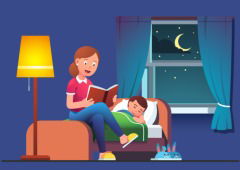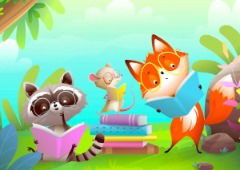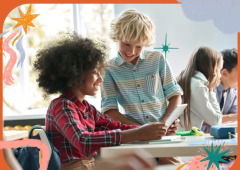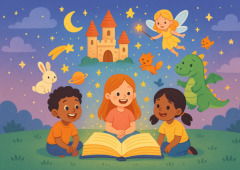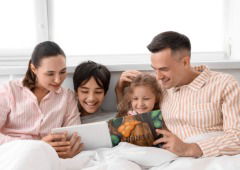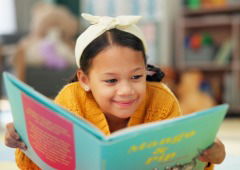7 cuentos cortos en inglés para que los niños aprendan el idioma
Los cuentos en inglés son herramientas poderosas en el proceso de aprendizaje. A través de historias simples y atractivas, los niños pueden relacionar palabras y estructuras con imágenes, emociones y situaciones cotidianas, lo que facilita la comprensión y retención del nuevo idioma.
El aprendizaje de nuevos idiomas es fundamental para el desarrollo cognitivo, social y emocional de los niños. En esta etapa el cerebro tiene una gran plasticidad, lo que facilita la adquisición de habilidades lingüísticas de forma natural y efectiva.
1. The Three Little Pigs - Joseph Jacobs
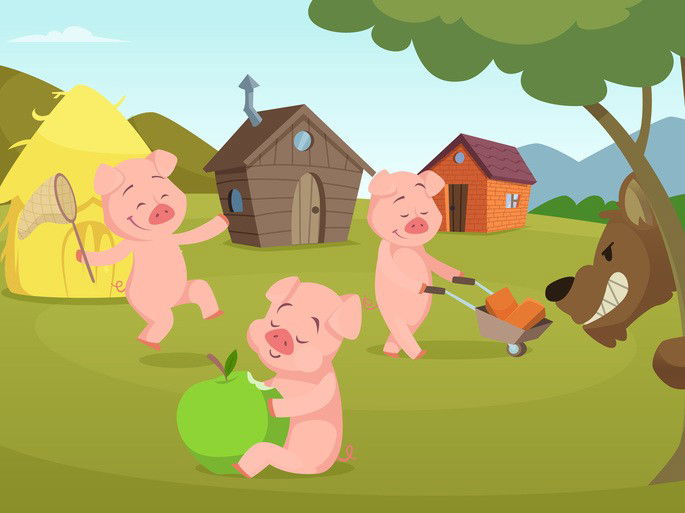
Once upon a time three little pigs lived happily with their parents in a small house in the forest. When the pigs grew up their parents said:
—It’s time to build your own houses.
The three pigs said goodbye and went into the world.
The first pig, who was lazy, decided to build a house of straw. He built it very fast. Then, he went to sleep.
The second pig, who loved to eat, built a house of wood. It didn’t take long. Then, he sat down to eat apples.
The third pig, who was very hard-working, built a house of bricks and cement. It took more time, but it was strong and safe.
After a long day, the house was ready. But in the forest, they could already hear the wolf howling. The hungry wolf came to the first house and said:
—Open the door! Open the door or I will blow your house down!
The pig didn’t open the door. So the wolf blew hard and the straw house fell down. The pig ran to the wooden house. The wolf followed him.
At the second house, the wolf said:
—Open the door! Open the door or I will blow your house down!
The second pig didn’t open the door. The wolf blew and blew, and the wooden house flew away! The two pigs ran to the brick house. The wolf followed them.
At the third house, the wolf said:
—Open the door! Open the door or I will blow your house down!
The hard-working pig said:
—Blow as much as you want! I will not open the door!
The wolf blew and blew. He blew with all his strength. But the brick house did not move.
The wolf was very tired. But he didn’t give up. He got a ladder and climbed to the roof. He went down the chimney.
But the pigs had a big pot of boiling water in the fireplace.
When the wolf fell down the chimney, he burned himself and ran away forever!
The three pigs lived happily and safely. The lazy and the hungry pig learned something important: only hard work gives good results.
Este clásico cuento transmite una enseñanza muy clara: la importancia del esfuerzo, la previsión y el trabajo bien hecho. Los dos primeros cerditos buscaban soluciones fáciles y rápidas, mientras que el tercero invirtió más tiempo y energía, construyendo algo duradero y seguro. Gracias a eso, todos se salvan del lobo.
¿Cómo ayuda al aprendizaje del inglés?
Este cuento es ideal para niños que están aprendiendo inglés porque:
-
Usa vocabulario básico: house, pig, wolf, door, run, sleep, eat, wood, brick, straw, open, strong, blow, etc.
-
Repite estructuras gramaticales simples, como:
-
"Open the door!" (imperativo)
-
"The pig said..." (pasado simple)
-
"The wolf blew and blew." (repetición con past tense)
-
-
Introduce formas verbales del pasado simple (built, ran, said, blew, fell, burned).
-
Refuerza la estructura if… then... implícita en frases como: "Open the door or I will blow your house down!"
Además, la historia es muy conocida, lo que facilita la comprensión y permite a los niños anticipar el vocabulario o asociarlo con la versión en español que ya conocen.
2. The Frog Prince - Brothers Grimm
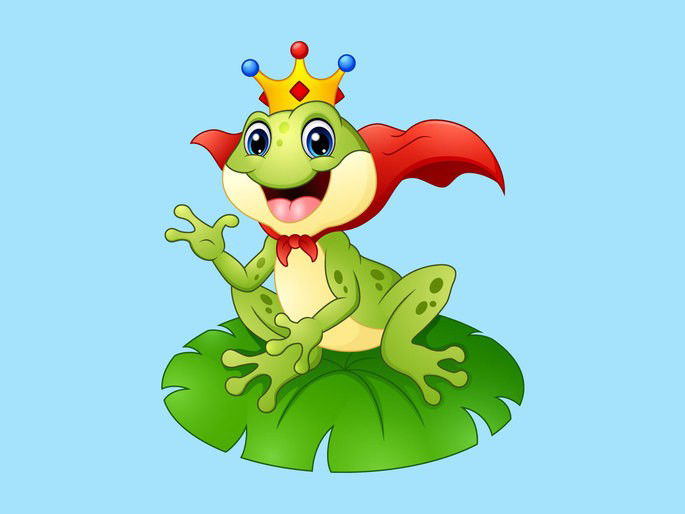
A long time ago there was a princess who loved golden things. Her favorite toy was a little golden ball. On hot days she liked to sit by a well and play with her ball.
One da, the ball fell into the deep well. She could not see the bottom.
—Oh no! I lost my golden ball! —the princess cried.
Suddenly, she heard a voice:
—Why are you crying, princess?
She looked around, but saw no one.
—Down here —said the voice.
She looked into the well and saw a frog.
—Oh, little frog —said the princess—. My golden ball fell into the well.
—I'll get it for you —said the frog—, but I want something in return.
—You can have my pearls, my jewels, even my gold crown —she said.
—What can I do with a crown? —said the frog—. I want to be your best friend. I want to eat with you and sleep at your castle sometimes.
The princess thought this was silly but agreed.
The frog jumped into the well. Soon he came back with the golden ball in his mouth.
He dropped the ball at the princess’s feet. She grabbed it quickly and ran away.
—Wait! —said the frog—. I can’t run that fast!
But the princess didn’t listen.
The next day, while she was having dinner with her family, she heard a strange sound at the door.
—Princess, open the door! —said a voice.
Curious, she opened the door and saw the wet frog. She shut the door quickly.
—Was it a giant? —asked the king.
—No, just a frog —she said.
—What does the frog want? —asked the king.
She told her father everything. The frog kept knocking and said:
—Don’t you remember your promise at the well?
The king said:
—You made a promise. You must keep it. Let him in.
The princess opened the door. The frog followed her to the table.
—Put me on the chair next to you —he said.
The king looked at her seriously, and she helped the frog up.
Then the frog said:
—Put me on the table. Give me your plate.
The princess gave him her plate but didn’t feel like eating.
After dinner, the frog said:
—I’m tired. Take me to your room.
The princess cried. But the king said:
—He helped you. You must be kind.
She picked up the frog with two fingers and put him in the corner of her room.
Soon, the frog said:
—I’m sleepy. Put me in your bed, or I’ll tell your father.
The princess did it. She lay in bed and heard the frog crying.
—What’s wrong now? —she asked.
—I only wanted a friend —said the frog—. But you don’t care about me. I will go back to the well.
These words touched the princess’s heart. She sat on the bed and said:
—Don’t cry. I will be your friend.
She gave the frog a kiss.
Suddenly, the frog turned into a handsome prince!
The princess was surprised and happy. They became good friends, and later, they got married and lived happily ever after.
El príncipe rana enseña la importancia de la amabilidad, el valor de cumplir las promesas y la necesidad de mirar más allá de las apariencias. La princesa aprende que la verdadera amistad y el amor vienen del corazón, no del aspecto físico.
Cómo ayuda al aprendizaje del inglés:
-
Vocabulario cotidiano: princess, frog, ball, crown, dinner, room, bed, friend, door, promise.
Estas son palabras frecuentes y útiles en muchas situaciones cotidianas, lo que permite a los niños expandir su vocabulario funcional de forma natural. -
Verbos en pasado simple: cried, said, saw, ran, opened, gave, kissed, turned.
Los niños pueden familiarizarse con formas comunes del pasado, esenciales para narrar historias y describir acciones. -
Práctica de diálogos:
El cuento incluye estructuras claras como "I want to…", "Don't cry", "What do you want?", que ayudan a los niños a expresar deseos, emociones y necesidades en inglés.
3. Jack and the Magic Beans - Hans Christian Andersen

Jack lived with his mother in a small house near the forest. They were very poor. One day, his mother said:
—Go to town and sell our cow. We need money.
Jack walked with the cow. On the way, he met a man.
—Look at these beans! They are magic. I will give you the beans for your cow —said the man.
Jack gave the man the cow and took the beans. He was happy.
When Jack got home, his mother was very angry.
—What? You gave away our cow for beans? —she cried. She threw the beans outside.
The next morning, Jack saw a giant beanstalk! It grew up to the sky.
Jack climbed the beanstalk. He found a big castle in the clouds.
Inside, he saw a giant and a magic chicken. The chicken laid golden eggs.
When the giant was asleep, Jack took the chicken and climbed down. His mother was happy. They sold the eggs and lived well.
But one day, the chicken died. Jack climbed up again.
This time, he saw the giant counting gold coins. Jack waited. When the giant slept, Jack took the bag of coins and ran home.
Now they had more money.
Later, the money was gone. Jack climbed the beanstalk again.
He saw the giant hide a small box. The box made gold coins appear!
Jack took the box. He also saw a magic harp. The harp played music alone.
When the giant slept, Jack took the harp. But the harp shouted:
—Help! Help! Someone is stealing me!
The giant woke up and ran after Jack.
Jack climbed down fast. The giant followed him.
—Mother! Bring me the axe! —Jack shouted.
His mother brought the axe. Jack cut the beanstalk.
The giant fell and never came back. Jack and his mother lived happily with the magic box.
Esta es una historia de valentía, ingenio y aventura. Aunque Jack parece ingenuo al cambiar la vaca por habichuelas, demuestra gran inteligencia y coraje para enfrentar al gigante, tomar decisiones rápidas y aprovechar las oportunidades.
También enseña cómo los errores pueden traer aprendizajes y nuevas posibilidades.
¿Cómo contribuye al aprendizaje del inglés?
Este cuento es ideal para niños en niveles iniciales de inglés por varias razones:
-
Vocabulario básico y repetitivo: palabras como cow, beans, mother, house, money, castle, coins, chicken, harp, box, giant, axe son fácilmente memorizables y útiles.
-
Verbos frecuentes en pasado simple: como gave, took, saw, threw, climbed, found, ran, shouted, cut, fell permiten que los niños se familiaricen con la estructura narrativa en pasado.
-
Estructuras simples y claras: muchas oraciones tienen sujeto + verbo + complemento, lo que ayuda a internalizar el orden básico de las frases en inglés.
-
Repetición de eventos: el hecho de que Jack suba varias veces al tallo refuerza el uso de expresiones como again, next time, then, later, útiles para estructurar secuencias en inglés.
4. The Princess and the Pea - Hans Christian Andersen
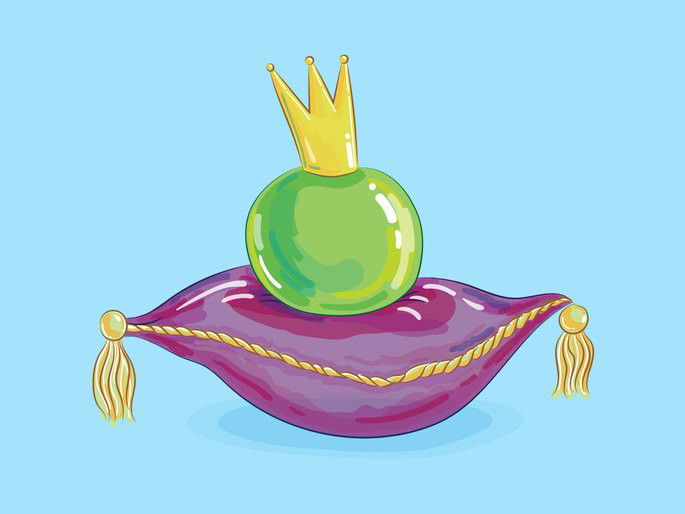
Once upon a time there was a prince who wanted to marry a real princess. He traveled around the world, but he could not find one. Some princesses looked real, but he was never sure.
One night, there was a big storm. It was raining, and the wind was blowing. Suddenly, someone knocked on the castle door.
Knock, knock!
The king opened the door. A girl was standing outside. She was wet from the rain.
“I am a princess,” she said.
The queen said nothing, but she wanted to know if the girl was a real princess.
That night, the queen put a small pea under twenty mattresses and twenty blankets. The girl slept on top.
In the morning, the queen asked, “How did you sleep?”
“Oh,” said the girl, “not well at all. There was something hard in the bed. I am very tired.”
The queen smiled. “Only a real princess can feel a pea through so many mattresses!”
The prince was happy. He married the real princess, and they lived happily ever after.
Esta historia transmite que la verdadera nobleza no se demuestra con palabras, sino con la sensibilidad, la delicadeza y la autenticidad. Además, enseña a no juzgar por las apariencias, sino a observar con atención y empatía.
Cómo ayuda al aprendizaje del inglés:
-
Vocabulario cotidiano: prince, princess, queen, king, castle, bed, mattress, blanket, pea, storm, rain, wind, door.
Este vocabulario introduce a los niños en el entorno de los cuentos clásicos, mientras que muchas de las palabras son también útiles en conversaciones cotidianas. -
Verbos en pasado simple: wanted, traveled, was, knocked, opened, said, put, slept, asked, smiled, married, lived.
Los verbos están en su forma regular e irregular, permitiendo reconocer y practicar estructuras básicas del pasado narrativo en inglés.
5. Goldilocks and the Three Bears - Robert Southey
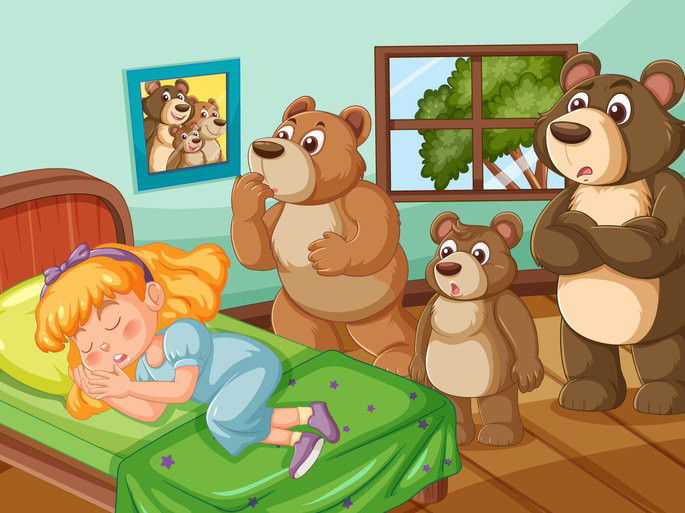
One afternoon, Goldilocks went into the forest to pick flowers. Near there was a very pretty little house. Since Goldilocks was very curious, she slowly went up to the door and pushed it.
The door was open. She saw a table.
On the table, there were three bowls of milk and honey. One was big, one was medium, and one was small. Goldilocks was hungry and tasted the milk from the big bowl. "Ugh! It is too hot!"
Then she tasted the medium bowl. "Ugh! It is too cold!"
Next, she tasted the small bowl. It was just right, so she drank it all.
There were also three blue chairs: one big, one medium, and one small. Goldilocks sat on the big chair, but it was too high. Then she sat on the medium chair, but it was too wide. Then she sat on the small chair, but she sat down so hard that she broke it.
She went to a room with three beds: one big, one medium, and one small.
She lay down on the big bed, but it was too hard. Then she lay down on the medium bed, but it was also hard.
Then she lay down on the small bed, and it was just right, so she fell asleep.
While Goldilocks was sleeping, the owners of the house—a family of bears—came back from their walk in the forest.
One bear was very big and wore a hat because he was the father. Another was medium and wore a bonnet because she was the mother. The other was a small bear and wore a little cap.
The big bear shouted loudly: "Someone has tasted my milk!"
The medium bear growled less loudly: "Someone has tasted my milk!"
The small bear said softly and cried: "Someone has drunk all my milk!"
The three bears looked at each other and did not know what to think. But the little bear cried so much that his father tried to distract him.
They went to the blue chairs.
The big bear shouted loudly: "Someone has touched my chair!"
The medium bear growled less loudly: "Someone has touched my chair!"
The small bear said softly and cried: "Someone sat in my chair and broke it!"
They continued searching the house and entered the bedroom.
The big bear said: "Someone has slept in my bed!"
The medium bear said: "Someone has slept in my bed!"
When they saw the small bed, they found Goldilocks sleeping.
The little bear said: "Someone is sleeping in my bed!"
Goldilocks woke up and saw the angry bears. She got scared and jumped out of bed.
Since a window was open, Goldilocks jumped out and ran through the forest until she found her way home.
Ricitos de oro enseña la importancia del respeto a la propiedad ajena y a los límites de los demás. La curiosidad de la niña la lleva a invadir un espacio privado sin permiso, lo que causa problemas.
Además, la historia muestra la búsqueda del equilibrio y la medida justa en las cosas: ni muy caliente ni muy frío, ni muy grande ni muy pequeño.
Cómo ayuda en el aprendizaje del inglés:
-
Vocabulario cotidiano: house, forest, milk, bowl, chair, bed, father, mother, baby bear.
-
Adjetivos comparativos y superlativos: big, medium, small, too hot, too cold, just right.
-
Estructura de oraciones simples: El cuento usa frases cortas, perfectas para niños que comienzan a aprender inglés.
6. Puss in Boots - Brothers Grimm
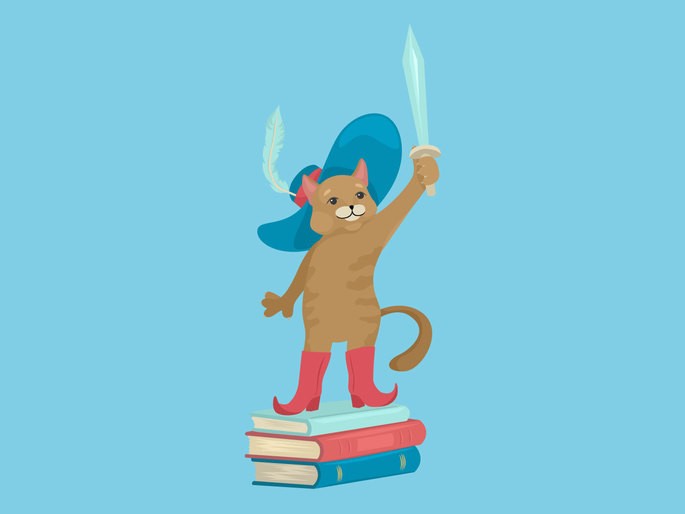
Once upon a time, there was a miller who had three sons, a mill, a donkey, and a cat. The sons had to grind the grain, the donkey had to carry the grain and flour, and the cat had to catch mice. When the miller died, the three sons divided the inheritance. The oldest son got the mill, the second son got the donkey, and the youngest got the cat, because that was all that was left.
The youngest son was sad and said to himself:
"I got the worst part. My older brother can grind, and my second brother can ride the donkey, but what will I do with the cat? If I make gloves from its skin, I will have nothing left."The cat said:
"Listen, don't kill me just to make gloves. Ask to make me some boots so people can see me. Then you will get help."The miller's son was surprised that the cat spoke like that, but a shoemaker was nearby, so he asked him to make boots for the cat. When the boots were ready, the cat put them on, took a sack, put grain inside, and closed it with a string. Then he walked on two legs like a person.
At that time, there was a king who liked to eat partridges, but no one could catch any because they were too fast. The cat knew this and planned to help.
He went to the forest and spread grain on the ground. The partridges came and entered the sack one by one. When there were many inside, the cat pulled the string and caught them. Then he took the sack to the king.
The guards shouted:
"Stop! Where are you going?""To see the king," the cat said.
The king was surprised to see the fat partridges and thanked the cat. He ordered that the cat take all the gold he could carry back to his master.
The youngest son was at home, thinking he had wasted his last money on the cat’s boots. Then the cat came and showed him the gold.
The cat said:
"Now you have money, but this is not the end. Tomorrow I will wear my boots again and you will be richer."Every day the cat hunted and brought gifts to the king. The king liked the cat and let him go freely in the palace.
One day, the cat overheard the coachman complaining that he had to take the king and princess for a ride.
The cat told his master:
"Go with me to the lake and bathe."The youngest son did as told. The cat hid his clothes. When the king came, the cat told him that his master was swimming but a thief had stolen his clothes. The king gave the young man his own clothes and he sat next to the king in the carriage.
The cat went to a meadow where many people were working and asked:
"Who owns this meadow?""Mr. Mage owns it," they said.
The cat told them to say it belonged to the Count (his master) when the king asked.
He did the same in a field and forest, convincing the workers to say the land belonged to the Count.
The cat then went to the mage's palace and asked him to show his magic transformations. The mage turned into an elephant, a lion, and a mouse. The cat caught the mouse and ate it.
The king came to the fields and was impressed by the Count’s lands.
The cat welcomed the king to the Count’s palace.
The king promised his daughter to the Count, who later became king himself. The cat became the prime minister.
Este cuento muestra que la astucia, la inteligencia y la creatividad pueden ayudar a superar situaciones difíciles, incluso cuando los recursos materiales son escasos.
Así, el gato usa su ingenio para cambiar la fortuna de su amo, demostrando que la inteligencia es tan valiosa como el dinero o el poder.
Cómo ayuda en el aprendizaje del inglés:
-
Vocabulario cotidiano: cat, boots, king, castle, gold, forest, partridge, sack, coat.
-
Estructuras verbales en pasado simple: was, had, said, went, caught, gave, became.
-
Expresiones útiles y frases para practicar diálogo: "Listen," "Don't kill me," "Who owns this meadow?" "I will wear my boots."
7. Cinderella - Charles Perrault
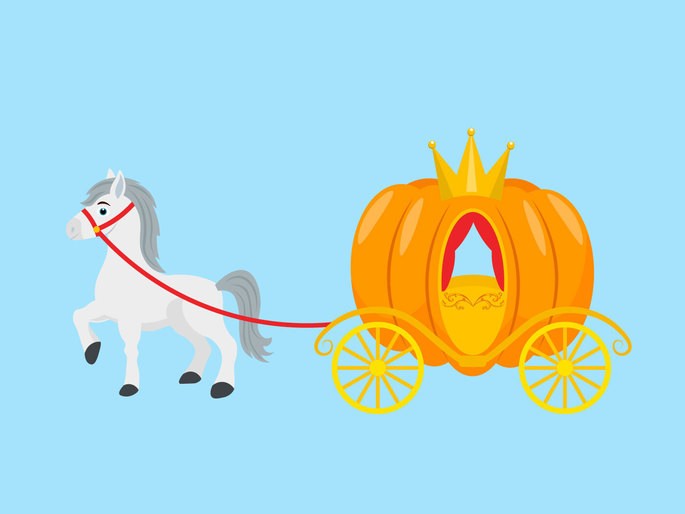
Once upon a time, there was a gentleman who married a proud and arrogant woman as his second wife. She had two daughters who were just as proud and unpleasant.
The gentleman had a daughter too, but she was very kind and sweet, like her mother who had been the best person in the world.
After the wedding, the stepmother showed her bad character. She could not stand the kindness of the young girl, which made her own daughters look worse. She forced the girl to do all the dirty chores in the house: cleaning floors, washing dishes, and tidying the rooms of the lady and her daughters. She had to sleep in the attic, on a poor straw mattress, while her stepsisters had beautiful rooms with fancy beds and mirrors.
The poor girl endured everything with patience and was afraid to complain to her father because his wife dominated him. After finishing her chores, she sat by the fireplace in the ashes, which is why they called her Cinderella.
The younger stepsister was not as bad and called her Cinderella kindly, but even with her poor clothes, Cinderella was much more beautiful than her proud stepsisters.
One day, the king’s son gave a ball and invited all the important people. The two stepsisters were invited and spent days preparing their dresses and hairstyles. Cinderella helped them with their clothes and hairstyles, but when they asked if she wanted to go to the ball, she said no, because she thought no one would take her seriously.
When they left for the ball, Cinderella cried. Her godmother, who was a fairy, saw her and asked what was wrong. When Cinderella said she wanted to go to the ball, the fairy told her to be good and promised to help her.
The fairy asked Cinderella to bring a pumpkin from the garden. She turned the pumpkin into a golden carriage. She transformed six rats into six horses and a mouse into a coachman. She also turned six lizards into servants.
Then she touched Cinderella’s clothes with her magic wand and turned them into beautiful golden and silver dresses embroidered with gems. She gave her a pair of glass slippers.
The fairy warned Cinderella to return before midnight, or everything would turn back to normal.
At the ball, everyone admired Cinderella’s beauty. The prince danced only with her and gave her fruits as gifts. When the clock struck almost midnight, Cinderella hurried away, leaving one glass slipper behind.
The prince searched for the owner of the slipper and proclaimed he would marry the woman whose foot fit it.
The stepsisters tried to fit their feet, but they failed. Cinderella asked to try, and the slipper fit perfectly.
The fairy made Cinderella’s clothes even more beautiful again, and she forgave her stepsisters for their bad treatment. Soon, Cinderella married the prince and took her stepsisters to live in the palace, marrying them to noblemen.
La historia de La Cenicienta enseña valores como la paciencia, la bondad, el perdón y la justicia. Aunque sufre injusticias y maltratos, la protagonista mantiene su nobleza y buen corazón, lo que al final la recompensa con felicidad y reconocimiento.
Cómo ayuda en el aprendizaje del inglés:
-
Vocabulario cotidiano: stepmother, stepsisters, chores, pumpkin, carriage, fairy, glass slippers, ball, prince, dresses.
-
Tiempos verbales simples: was, had, said, went, came, gave, tried.
-
Frases para practicar diálogo: "Would you like to go to the ball?" "Be good." "The slipper fits!"
Ver también:








